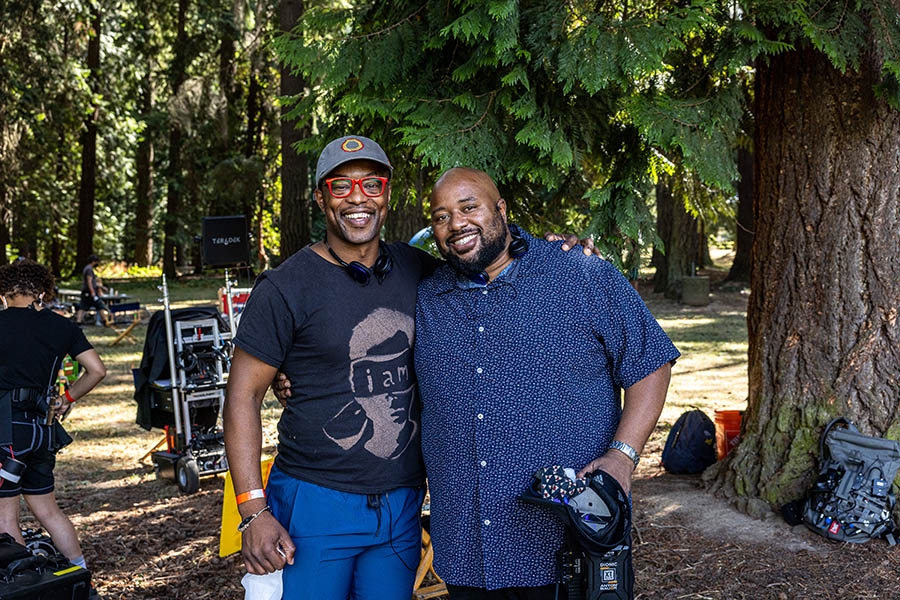Outdoor School — a $2.5 million film meant to showcase the reality of homelessness and Black life in 1990s Portland — wrapped shooting in mid-September. But filmmakers pioneered a recruitment model they hope will be a boon to aspiring filmmakers of color — and to Oregon’s film industry.
Beneath the swaying branches of Pier Park in North Portland, Vin Shambry watched his younger self with one hand over his heart.
He was surrounded by a full film-production crew, but his gaze rarely left Karter Halliday, the Portland actor who plays the 12-year-old version of Shambry in Outdoor School, an autobiographical film he helped write and produce, shot in Portland this year.
On the September day Oregon Business visited the Outdoor School set, the crew shot what Shambry said was a particularly painful scene to revisit. In it, young Vin shoves his sister (played by Zion Howard, another Portland-based child actor) to the ground for scuffing his favorite — and only — pair of Nikes.
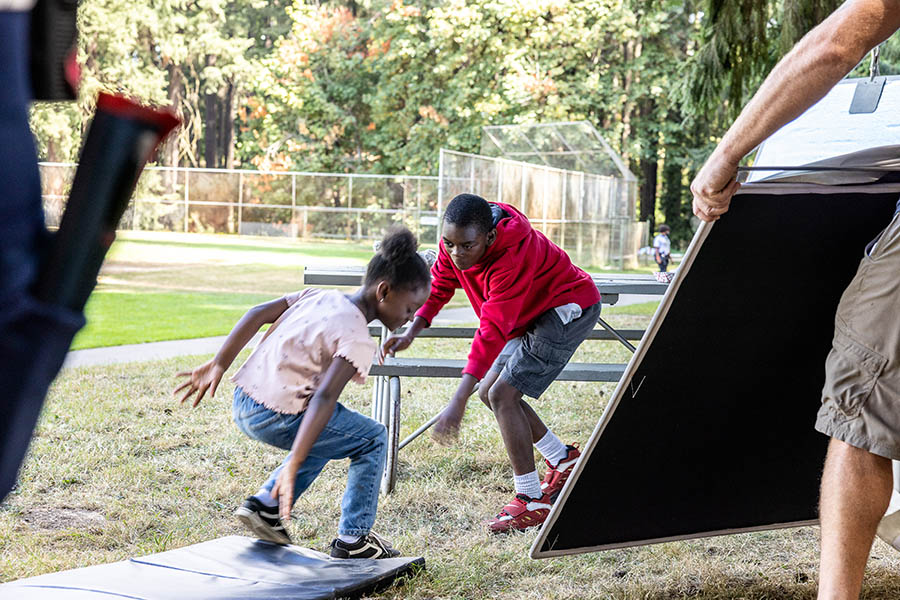 Young Vin, played by Karter Halliday, at right, and his younger sister, played by Zion Howard. Photo by Jason E. Kaplan
Young Vin, played by Karter Halliday, at right, and his younger sister, played by Zion Howard. Photo by Jason E. Kaplan
The scene is meant to capture the anger and frustration the younger Shambry felt as a child, and the movie as a whole portrays a painful episode in the writer’s past. When Shambry was 12 years old, his mother woke up him and his 4-year-old sister in the middle of the night with blood pouring from her mouth — the result of abuse by Shambry’s father — and told them it was time go.
The family left their home in North Portland and spent the nights sleeping in Portland’s Irving Park under a 50-foot-tall tree with branches that hung so low the family was covered as they slept. They couldn’t sleep in a shelter for fear of being separated, and they developed a nightly routine to avoid police patrols. They took showers at a local swimming pool and ate free breakfast at school, so Shambry was able to conceal his living conditions from his classmates.
Shambry says being homeless meant he had to grow up fast, and he never got the full experience of being a carefree kid. Then he took a trip with his sixth-grade class to Camp Collins in Oxbow Regional Park as part of Oregon’s Outdoor School, a statewide program meant to teach schoolchildren about nature firsthand.
Shambry says the trip was transformative. While he was initially excited to have all his meals cooked and a bed to sleep in, the experience of connecting with nature made him unashamed of his living situation. His time spent in the wilderness helped him realize his place in the world — as a son, a brother and a protector of his family.
“It made me realize that I had always been enough,” he tells OB. “I was a camper even before I had ever gone camping. Even though I was sleeping under a tree in the park, I was still a part of it all.”
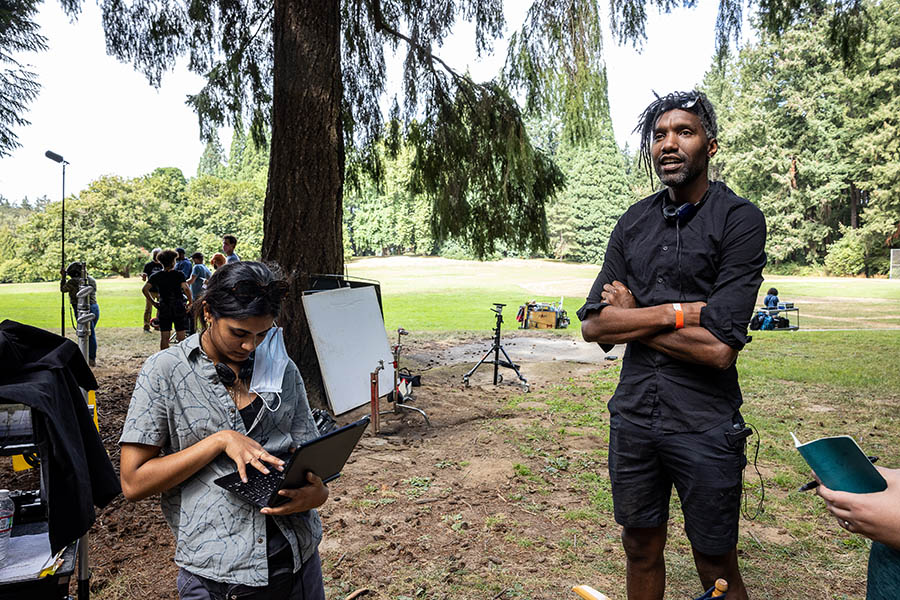 Producer Ifanyi Bell (right) on-site. Photo by Jason E. Kaplan
Producer Ifanyi Bell (right) on-site. Photo by Jason E. Kaplan
When Shambry developed Outdoor School with Portland director Ime Etuk and producer Ifanyi Bell, the group had two goals in mind: to share his story with a broader audience and to develop Oregon’s film-crew workforce by giving training and on-set experience to film-crew workers of color.
The filmmakers hope the project will serve as a catalyst for diversifying Oregon’s film-crew talent pool — and make the state a more attractive place to shoot.
After graduating from Grant High School in 2001, Shambry left Portland to attend the University of Wyoming, and ultimately received his Bachelor of Fine Arts at the American Musical and Dramatic Academy in New York in 2005. After graduation, he acted on Broadway, taking roles in Rent and Miss Saigon before returning home to Portland in 2011. He’s a resident artist at Portland’s Artists Repertory Theatre, and his account of his Outdoor School experience was published in Occasional Magic, a 2019 collection of stories from the popular storytelling series “The Moth.” The book is a New York Times bestseller.
Shambry met director Ime Etuk in Portland on the set of a Secret deodorant commercial that aired during the 2017 Super Bowl. The pair immediately connected and began discussing ideas for a collaboration.
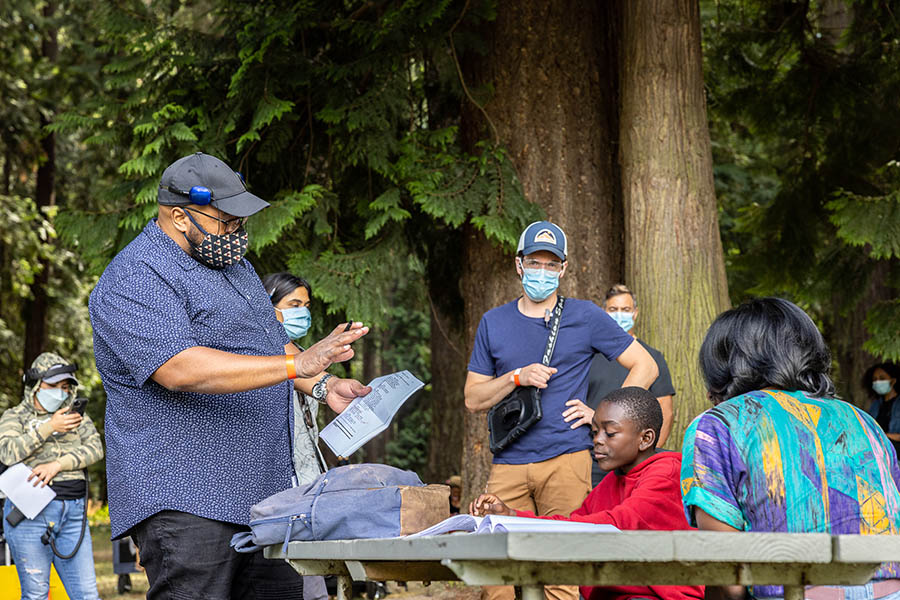 Director Etuk at work. Photo by Jason E. Kaplan
Director Etuk at work. Photo by Jason E. Kaplan
When Etuk heard the story of Shambry’s childhood, he knew he had to bring it to the world.
“When I heard his story, I knew it was amazing,” Etuk tells OB. “I didn’t know his story had been a New York Times bestseller or anything like that. I just knew I had a production company, I had a few cameras, and that I needed to tell this story.”
Etuk founded Laugh Cry Love Entertainment in 2012; his directing resume includes the 2009 feature Hurricane in the Rose Garden, as well as a slate of commercials and short films. He’s also worked on film and television sets for more than 20 years, primarily as an assistant director, with recent credits including the FX docuseries Outlaw: The Saga of Afeni and Tupac Shakur as well as Hulu’s Shrill and Showtime’s 2017 revival of Twin Peaks.
The two then contacted Ifanyi Bell, executive producer of Open Signal, a Portland media-arts incubator. Bell’s organization had a development program for Black film projects, and after raising the movie’s budget from local Black businesses, Outdoor School began shooting in August, with Etuk as the director.
Bringing Shambry’s story to life wasn’t enough for the filmmaking team. They wanted the business side of the movie to be as forward-thinking as the subject matter. They understood too well how difficult it was for film-crew workers of color to find work in the industry, and they wanted their project to address racial gaps present in filmmaking.
As part of the preproduction process, Etuk founded Lion Speaks, a nonprofit dedicated to giving people of color more opportunities in the film industry. His nonprofit’s first project was to staff the Outdoor School crew, which the organization did in collaboration with Open Signal.
Lion Speaks and Open Signal staffed 25 of the film’s 113 paid crew members. The crew positions mean more than just a paycheck: Film credits are the most valuable way to get another job and into the local International Alliance of Theatrical Stage Employees (IATSE) Local 488, the film-workers union representing Oregon, Washington and Northern Idaho. More than 70% of the Outdoor School crew are either BIPOC or women.
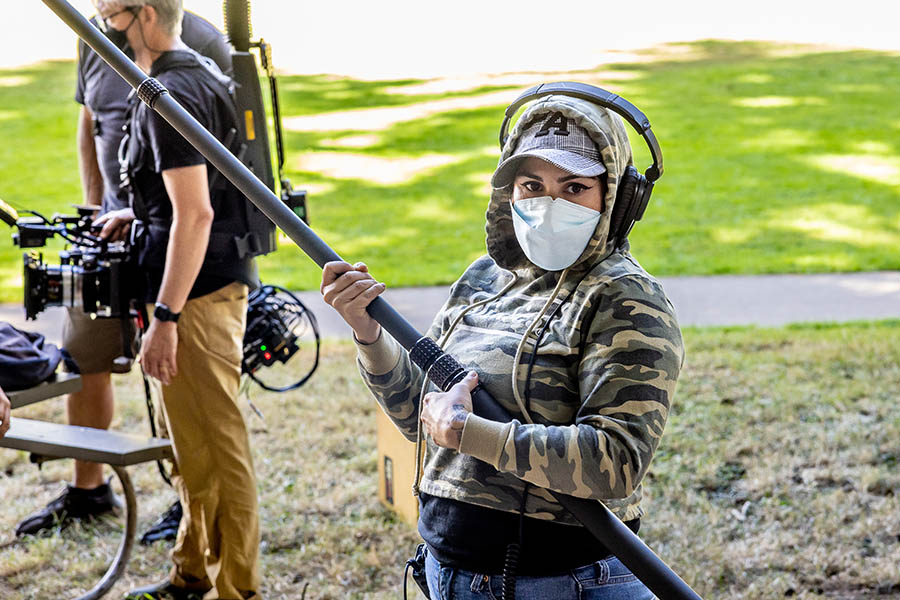 Outdoor School boom operator Rachel Saldivar. Photo by Jason E. Kaplan
Outdoor School boom operator Rachel Saldivar. Photo by Jason E. Kaplan
“For me, it’s about more than just making movies,” Etuk says. “We said, ‘What if we used this thing to help elevate up-and-coming Black filmmakers and give people an opportunity that they maybe haven’t had yet?’ We are blessed to be working in these environments, but there are not a lot of people that look like us. We aren’t reflected. So we are going to do our part to elevate the next group of folks.”
A 2021 industry report from McKinsey & Company found people of color were “significantly underrepresented” on film sets. Despite being 13.6% of the U.S. population, only 6% of film directors or producers were Black, and only 4% of writers. Film crews faced similar disparities, with only 8.2% of film-crew workers identifying as African American.
The industry remains predominantly white (87%) and male (63%) — and that’s not good for business. The report estimated that by hiring more people of color and women, the film industry could increase its annual revenue by $10 billion — a 7% increase from the assessed baseline of $148 billion.
The model of recruiting and training crew through a nonprofit helps the film’s bottom line. Etuk says half a million dollars — 25% of the movie’s overall budget — was raised through donations to Lion Speaks and Open Signal from community partners. Donors include Meyer Memorial Trust, the Miller Foundation, Moda Center and Portland General Electric.
Bell says that even after the movie wraps shooting, Outdoor School will continue to pay dividends by creating a better-trained, more diverse film talent pool in the state. He also hopes to re-create the nonprofit-partnership model for other film projects.
“I’m hoping that once it’s done, we can start to replicate this model and refine it to the point where what we’re doing is no longer trailblazing and new. We want producers to see how valuable this process of hiring film crew through nonprofits can be, to the point where it’s no longer a foreign concept to them,” says Bell.
“There’s always excuses about why representation hasn’t been more common within the filmmaking [industry] in general, but at the end of the day, it comes down to money, ownership, representation and access,” he adds. “That means taking the time to reach out and find people to help you tell stories that are accurate, rather than stories manipulated by bias, misogyny and all things that, quite frankly, Hollywood has been known for doing.”
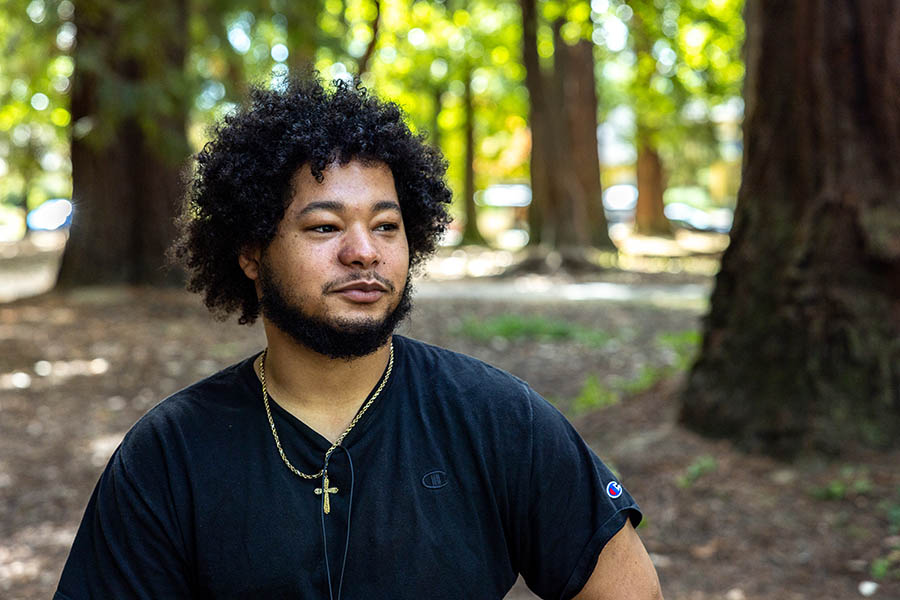 Production assistant Pasqueale JeVon Eddinger. Photo by Jason E. Kaplan
Production assistant Pasqueale JeVon Eddinger. Photo by Jason E. Kaplan
For production assistant Pasqueale JeVon Eddinger, working on Outdoor School has meant the revival of a dream he thought had passed him by. Eddinger was recruited for the film by Lion Speaks, giving him his first film credit. An electrical engineer, Eddinger received a full day of training from the organization before his first day on the job.
“This experience has been so much more than I expected. I had always dreamed of being on a movie set. I was really involved with media in high school, and I got to wake up this morning and be on a movie set,” says Eddinger. “It’s kind of a miracle.”
Tim Williams, executive director of Oregon Film, the state’s film office, says the Outdoor School project model is exciting for the industry’s long-term prospects. He says diversity, equity and inclusion work is top of mind at many networks and production companies, and the ability to hire a diverse film crew to meet DEI goals will give Oregon’s film industry a leg up on the competition.
“It has taken a while to get there, but the networks and the greater film industry are getting really serious about DEI work,” says Williams. “In the short term, the Outdoor School project is going to get us a great movie, but it’s the long-term inclusion work that’s the really exciting part of the project.”
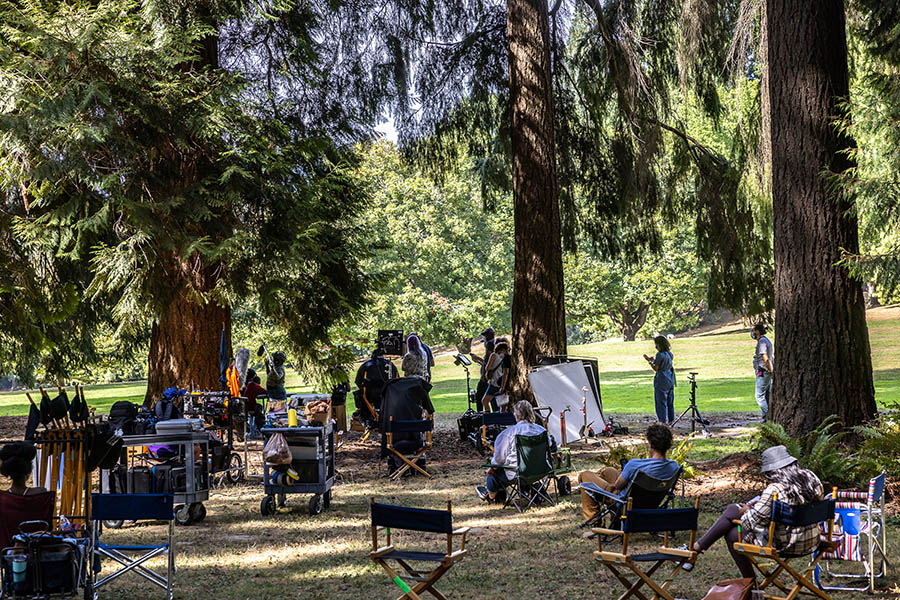 The Pier Park film set of Outdoor School. Photo by Jason E. Kaplan
The Pier Park film set of Outdoor School. Photo by Jason E. Kaplan
In 2020 the Academy of Motion Picture Arts and Sciences set representation and inclusion standards for films to qualify for the 2024 awards. In order to be eligible, films must have either a lead actor from an underrepresented racial or ethnic group, 30% of secondary and minor roles from at least two underrepresented groups, or a storyline or subject matter centered on an underrepresented group. Films that want to be considered for the award must also source at least 30% of their film crews from underrepresented groups.
Williams stepped into his role at the state film office in 2014. Under his tenure, Oregon has punched above its weight class as a movie state. Recent hits include Top Chef, which filmed its 18th season in the City of Roses, Shrill (produced by David Cress, who also acted as a producer on Portlandia) and the Nicolas Cage film Pig.
The Oregon Office of Film & Video brought $103 million in film, television, commercial and media production spending to the state during the 2020-2021 fiscal year, despite the COVID-19 pandemic. This spending supported more than 3,000 Oregon jobs, according to Oregon Film.
The office currently offers a 25% rebate on goods and services, 26.2% rebate on labor, and 25% rebate for purchases or rentals from Oregon vendors to any film project shooting in Oregon with a budget of at least $1 million. This year Oregon increased the state’s tax incentives and rebates program’s cap from $14 million to $20 million.
But Oregon’s incentive program still lags behind Washington, California, and Ontario, Canada. Washington offers a 30% rebate on in-state expenditures and has a lower minimum spend. California’s cap is $330 million — more than 16 times the size of Oregon’s.
For Shambry, no part of the recruitment process meant more than finding the young actor meant to portray him as a child. When local film producers want a child actor capable of carrying a lead role, they often bring in out-of-state talent. Shambry assumed his production would do the same, until he met Karter Halliday, who approached him while Shambry was auditioning for another part at Dr. Martin Luther King Jr. Elementary School in Northeast Portland.
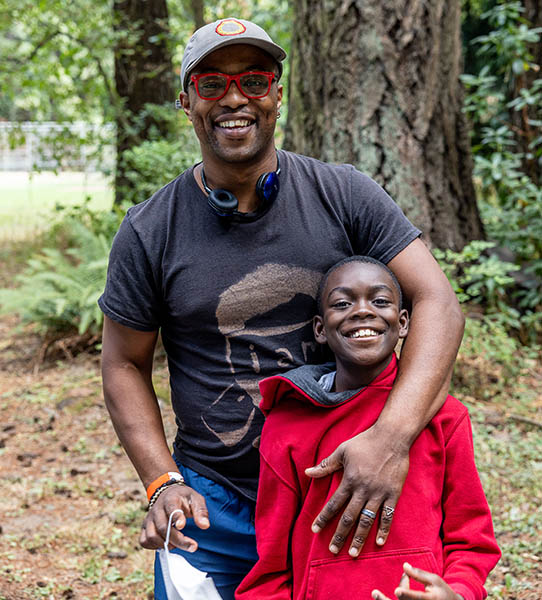 Vin Shambry and Karter Halliday, the young Portland-based actor who portrays him in the film. Photo by Jason E. Kaplan
Vin Shambry and Karter Halliday, the young Portland-based actor who portrays him in the film. Photo by Jason E. Kaplan
“We were there looking for little Black girls to play my sister, and this boy Karter came up to us, sat down next to us in the cafeteria and introduced himself,” Shambry says. “He said he wanted to be a performer, and he asked if we like chicken. I said I was a vegetarian, but I saw the hustle. I saw the glint in his eye, and I said, ‘I see myself in this kid.’”
Shambry says the process of bringing Outdoor School to life has been inspiring. He even brought his mother to the set, where she got to see the story of her family as it was being brought to the big screen.
“I called her up and she was like, ‘When is that play going to happen, Junior?’ And I told her ‘No, Mom. It’s not a play, Mom. It’s a real movie,’ and she got so excited,” says Shambry. “She’s all about it.”
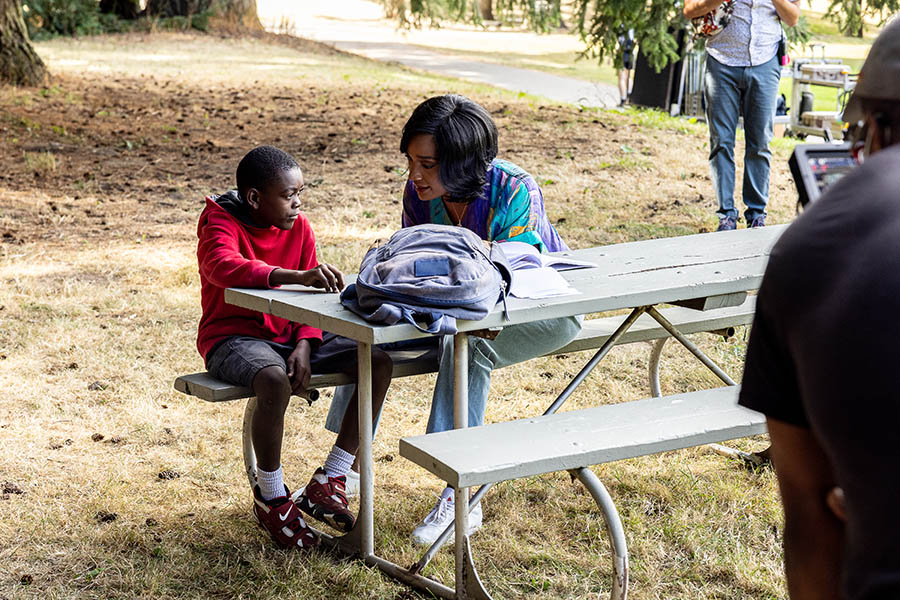 Halliday as young Vin and actor Cycerli Ash, who plays his mother. Photo by Jason E. Kaplan
Halliday as young Vin and actor Cycerli Ash, who plays his mother. Photo by Jason E. Kaplan
Shambry says Outdoor School is a story of endurance, and that seeing so many Black creators working on a project together has been inspiring.
“This isn’t just my story. It’s a lot of people’s stories. It’s the story of Black Portland in the ’90s. It’s a story about the perseverance of Black women, and what they endure countless times without no one ever seeing it,” says Shambry. “This project is about something much bigger than us.”
To subscribe to Oregon Business, click here.


